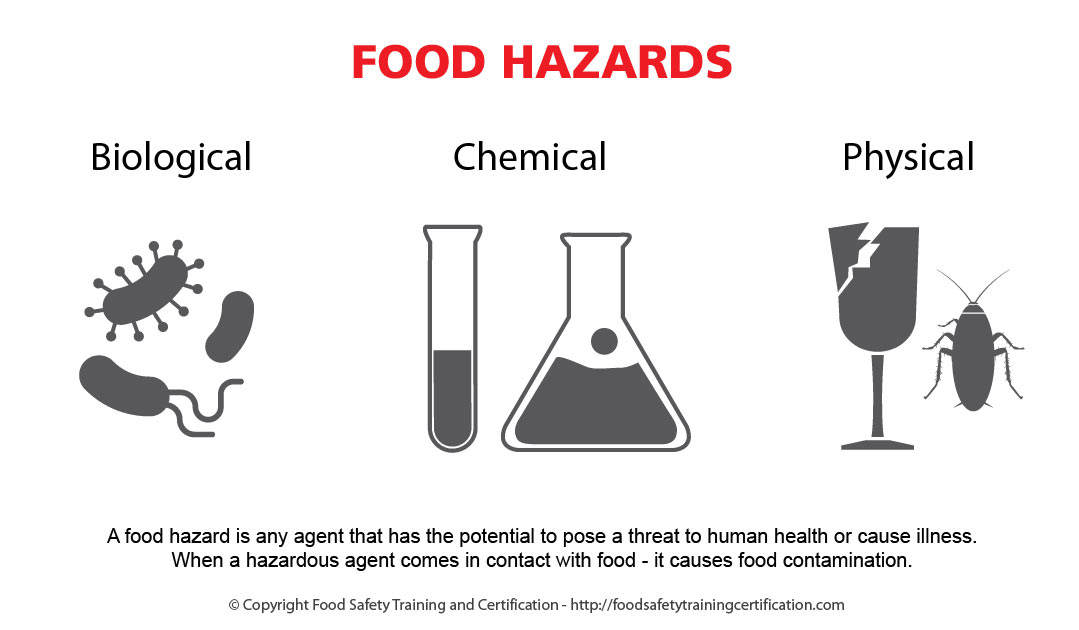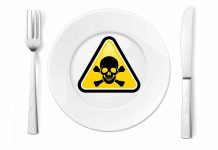Biological food hazards are biological agents that can pose a threat to human health. Biological hazards are the main causes of foodborne illness.
Biological food hazards are also called foodborne pathogens – or infectious organisms that are capable of causing human disease. These pathogenic organisms include bacteria, viruses, and parasites. With the exception of certain parasites, most biological foodborne pathogens are microscopic.

Introduction to Food Hazards
A food hazard is any agent that has the potential to pose a threat to human health or cause illness. When a hazardous agent comes in contact with food – it is called contamination.
Food hazards are generally classified by their sources:
- Biological Hazards: Biological hazards include bacteria, viruses, and parasites. Bacteria and viruses are responsible for most foodborne illnesses and are the biggest threat to food safety.
- Chemical Hazards: Chemical hazards include natural toxins and chemical contaminants (cleaning and sanitizing agents, natural toxins, drugs, food additives, pesticides, industrial chemicals, and other toxins).
- Allergens: Food allergens are a sub-category of natural toxins within chemical hazards. Some people are sensitive to certain proteins in foods. The 8 major food allergens include: milk, eggs, fish, crustacean shellfish (lobster, crab, shrimp), wheat, soy, peanuts, and tree nuts.
- Physical Hazards: Physical hazards are foreign objects which include glass, metal, plastic, bone chips, hair, insects, pest droppings, and other undesirable particles or objects.

General Symptoms of Biological Foodborne Infections
The most common result of infections from biological agents is gastroenteritis. Gastroenteritis, also called the “stomach flu”, is the inflammation of the gastrointestinal tract – the stomach and small intestine – and is typically caused by a virus, bacteria, or parasite.
- Learn about cross contamination, cold and hot food safety, best practices for personal hygiene, and foodborne illnesses.
- Food Manager ANSI Certification: SALE $99.00 - Valid in all States
- Food Handler ANSI Training for only $7.00!
- 10% OFF SALE: Enter Promo "TRAIN10OFF" at Checkout
Gastroenteritis is generally acquired through contaminated food or water, or through direct contact with an object, surface, or person – as a result of poor sanitation and/or hygiene. The main symptoms people will have are watery diarrhea and vomiting – along with stomach pain, cramping, fever, nausea, and a headache. Because of diarrhea and vomiting, individuals can also become dehydrated.
Parasitic infections also cause gastroenteritis, but other symptoms can vary – depending on the particular organism and severity of the infection. Symptoms can include muscle pain, cough, skin lesions, malnutrition, weight loss, swollen lymph nodes, neurological problems, and others.

Vulnerable Groups
As with all foodborne illnesses, certain populations are more susceptible to becoming ill or developing a greater severity of the illness. These groups include:
- Pregnant women;
- Infants and young children;
- Older adults;
- People with weakened immune systems from medical conditions, such as diabetes, liver disease, kidney disease, organ transplants, or HIV/AIDS;
- People taking certain kinds of medications for medical conditions – or receiving chemotherapy or radiation treatment.

Types of Biological Hazards
Biological hazards include bacteria, viruses, and parasites. Bacteria and viruses belong to a class of organisms called microorganisms – which are microscopic organisms that exist as unicellular, multicellular, or cell clusters. Microorganisms are widespread in nature and are beneficial to life, but some can cause serious harm to humans. Bacteria and viruses are responsible for most foodborne illnesses and are the biggest threat to food safety.
A parasite is an organism that lives on or in a host organism and gets its food from or at the expense of its host. Parasites are different from bacteria or viruses because their cells share many features with human cells including a defined nucleus.

References
- FoodSafety.gov – Bacteria and Viruses
https://www.foodsafety.gov/poisoning/causes/bacteriaviruses/index.html - The National Institute of Diabetes and Digestive and Kidney Diseases Health Information Center
https://www.niddk.nih.gov/health-information/digestive-diseases/foodborne-illnesses - CDC – Food Safety
https://www.cdc.gov/foodsafety/foodborne-germs.html - U.S. FDA – Foodborne Illnesses
https://www.fda.gov/food/consumers/what-you-need-know-about-foodborne-illnesses - U.S. FDA – Foodborne Pathogens
https://www.fda.gov/food/outbreaks-foodborne-illness/foodborne-pathogens - U.S. National Library of Medicine – Medline Plus – Bacterial Infections
https://medlineplus.gov/bacterialinfections.html - Centers for Diseases prevention and Control (CDC) – Norovirus
https://www.cdc.gov/norovirus/trends-outbreaks/burden-US.html - Mayo Clinic – Noroviros Infection
https://www.mayoclinic.org/diseases-conditions/norovirus/symptoms-causes/syc-20355296 - CDC- Parasites:
https://www.cdc.gov/parasites/ - U.S. National Library of Medicine – Medline Plus – Parasitic Diseases
https://medlineplus.gov/parasiticdiseases.html - FDA – Fish and Fishery Products Hazards and Controls Guidance
https://www.fda.gov/food/seafood-guidance-documents-regulatory-information/fish-and-fishery-products-hazards-and-controls-guidance-4th-edition - USDA – Parasites and Foodborne Illness
https://www.fsis.usda.gov/wps/portal/fsis/topics/food-safety-education/get-answers/food-safety-fact-sheets/foodborne-illness-and-disease/parasites-and-foodborne-illness/


























